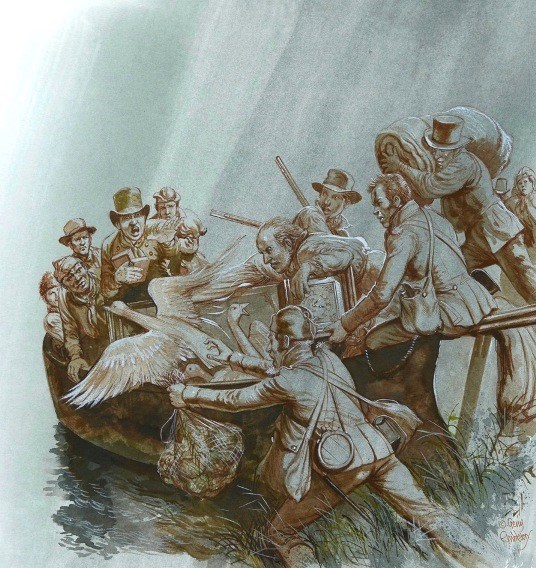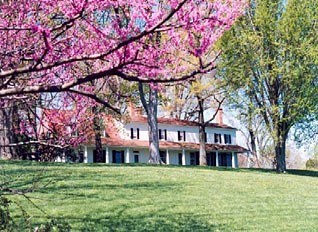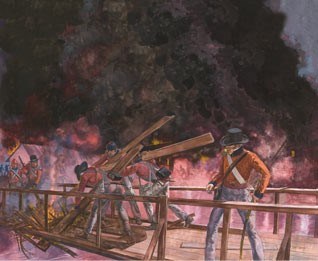
Leading up to the official declaration of war, the United States used trade restrictions in an effort to pressure Britain to stop its impressment of American sailors and its enforcement of the Orders-in-Council—Britain’s set of legislation that restricted trade with the United States prior to the War of 1812. The British Admiralty declared a naval blockade of the Chesapeake and Delaware bays in December 1812. By February 1813 Britain began enforcing the blockade with warships. The blockade was extended from New York to New Orleans that May, further restricting American trade with foreign markets. The War of 1812 had a devastating effect on commerce. The US trade restrictions leading up to the war dramatically decreased American exports. The British blockades and direct attacks on tobacco stores and other US trade goods made it difficult to conduct commerce during the war. Both to compensate for this loss in commerce, and also to harm British shipping, the United States government encouraged the deployment of private armed vessels, or privateers. Privateers, many built at Baltimore shipyards, carried the War of 1812 to the high seas, harassing British shipping in the West Indies, Gulf of St. Lawrence, near the British Isles, and elsewhere. While neither side militarily won the war, other powerful countries recognized that the United States was willing to fight to preserve its maritime rights, giving the nation new respect on the world stage. Pivot PointEconomic recovery from the war’s impact on trade and commerce varied depending on the region. In the Chesapeake, particularly in agrarian areas, the recovery was especially difficult. However, for some areas, restrictions on trade boosted manufacturing.Transportation, particularly the growth of an infrastructure of roads and canals, accelerated following the war, as the young nation developed its interior lands. Some historians say that the War of 1812 was a pivot point for the United States, as its economy changed from looking east to overseas markets to looking west at new frontiers. PrivateersThroughout the war, privateers augmented the small US Navy. They were sailors and private ships authorized by the federal government to harass, damage, and capture British merchant ships. Privateers were also authorized to sell the captured vessels and cargo for profit.When the British blockaded the Bay, American warships were trapped, but lower-profile boats could sometimes get past the blockade. Privateer ships were fast, agile schooners, designed for speed under sail. They were built in the Baltimore neighborhood of Fells Point and other Chesapeake Bay shipyards. The US government issued 1,100 commissions to privateers between 1812 and 1815. These self-styled marauders cruised the high seas looking for British merchants to pillage. Privateers did major damage to Great Britain’s sea trade and threatened that country’s economy. The port of Baltimore was a privateer hub. In 1814 the British attacked Baltimore in part to punish the homeport of the vexing privateers. 
Chesapeake’s Wartime AgricultureIn 1812, much of the Chesapeake region was farmland. When the British blockaded the Bay in December 1812, they cut off an economic lifeline for farmers, businessmen, and the shipping industry, particularly those involved in trade with Europe.British trade restrictions combined with confiscation of tobacco and ships, destructive raids, and encouraging enslaved African Americans to escape their masters all affected the economy in the Chesapeake and elsewhere along the US coast. During wartime and throughout the 19th century, tobacco was the main cash crop in Chesapeake areas where agriculture was prominent, especially Southern Maryland. Growing and harvesting tobacco required a large labor force, and enslaved people and tenant farmers made up a significant part of the agrarian population and economy. Many Americans involved in agriculture had opposed the war, perhaps for fear of its potential effect on their livelihood. Their fears were well founded, for in many areas, particularly along the rivers, planters experienced great losses when their crops were destroyed, their livestock confiscated, and their labor force reduced. Merchants dependent on crops for trade were also affected, as storehouses were destroyed in enemy raids and the blockade halted shipping. Most of the large-scale plantation owners were eventually able to recover from the economic losses they experienced. For many tenant farmers who worked the land, however, recovery was more difficult. When their crops were burned in British raids, many of these farmers were unable to pay their rent and were forced to leave, often heading west. John R. Plater from Sotterley Plantation noted that this was the plight of many tenant farmers who had resided on his land. 
(c) Gerry Embelton Chesapeake’s Wartime IndustriesAlthough agriculture dominated the economy of the Chesapeake region at the time of the War of 1812, there were military and maritime industries in the region that were also affected. The war actually gave a boost to manufacturing in some areas. Military industries, such as gunpowder mills, ropewalks, and arms manufacturers, profited from the war.Following the American Revolution, President George Washington commissioned a new United States arsenal and armory at Harpers Ferry, Virginia, now West Virginia, and some of the rifles used in the War of 1812 were manufactured there. Virginia’s legislature authorized construction of an armory to manufacture weapons for the state in 1797. It was the only state after the Revolutionary War to arm its own forces with state manufactured weapons. The Virginia Manufactory began production in Richmond in 1801. The Columbian Foundry, or Foxall Foundry, located in western District of Columbia produced 32-pounder carronades for the US frigate Constitution. During the War of 1812, this foundry was the leading manufacturer of ordnance for the US government. Other ordnance foundries in the Chesapeake region included Mount Aetna Furnace in Washington County, and Northampton Foundry in Baltimore County. The largest manufacturer of gunpowder in the US was DuPont Gunpowder Company northwest of Wilmington, Delaware. In 1813 the US government ordered 500,000 pounds of power from the firm, some of it intended for use at Fort McHenry. To protect this prime military target, President Madison ordered the Corps of the Brandywine Rangers exempt from other military service in order to protect the mill. Other producers of gunpowder in the Chesapeake region included Aetna Powder Mill and Bellona Gunpowder Mills, Baltimore County, Maryland. Ropewalks were used in making line for rigging of ships. Several ropewalks were located in Baltimore, Portsmouth, and Washington. When Washington was occupied by the British in August 1814, at least two ropewalks were burned because they were considered military targets. When Baltimore was threatened by attack in September 1814, one of the ropewalks below Hampstead Hill was burned by the Americans to keep it from the British. Not all military industries prospered. The British directed raids on industrial complexes when opportunity presented itself. Cecil Furnace in Cecil County, Maryland, suffered. Better known as Principio Iron Works, the furnace supplied 24-pounder long guns for the US frigate Constitution. The complex in 1813 consisted of a blast furnace, two air furnaces, and a boring mill capable of boring five cannon at one time. On May 3, 1813, the British destroyed the iron works as well as 36 cannon and 4 carronades ready to be shipped. The British also destroyed the foundry and cannon boring machinery and burned the mills, coal houses, and the bridge across Principio Creek. The total loss to the owner was around $20,000. Colonel Samuel Hughes rebuilt the works the same year and on December 16, 1813, received a contract for 40 cannons. But Hughes never recovered from his debts and was forced to sell the property. |
Last updated: June 4, 2020
